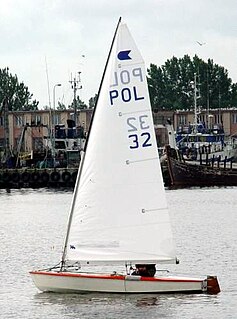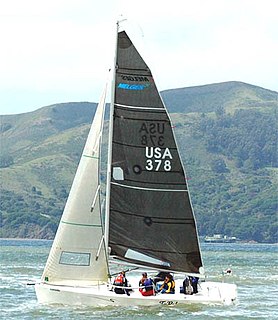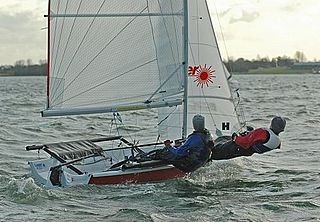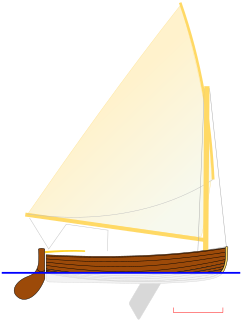
Sailing employs the wind—acting on sails, wingsails or kites—to propel a craft on the surface of the water, on ice (iceboat) or on land over a chosen course, which is often part of a larger plan of navigation.

Dinghy sailing is the activity of sailing small boats by using five essential controls:

Dinghy racing is a competitive sport using dinghies, which are small boats which may be rowboats, have an outboard motor, or be sailing dinghies. Dinghy racing has affected aspects of the modern sailing dinghy, including hull design, sail materials and sailplan, and techniques such as planing and trapezing.

The Laser is a highly popular family of small one-design sailing dinghies using the same common hull and interchangeable rigs with different sail areas. The Laser is designed to be sailed single-handed although class rules permit two sailors. Bruce Kirby designed the Laser in 1970 with an emphasis on simplicity and performance.

The Optimist, also known as the ‘opti’, 'oppie', 'opy' or 'bathtub' is a small, single-handed sailing dinghy intended for use by children up to the age of 15. Contemporary boats are usually made of fibreglass, although wooden boats are still built.

The OK Dinghy is an international class sailing dinghy, designed by Knud Olsen in 1956.

The Melges 24 is a one-design class of sailboat commonly used for racing. The monohull sportsboat is notable for its ability to plane over the water downwind in modest winds, and for its combination of a simple design that is highly tunable.

The Fireball is a British sailing dinghy that was designed by Peter Milne as a one-design racer and first built in 1962.

The Laser 4000 is a racing dinghy crewed by two persons. Its one-design weight-equalised system enables physically differing sailors to compete on a level playing field. It is most popular in Europe, particularly the UK, France and Italy.

The 18 ft Skiff is considered the fastest class of sailing skiffs. The class has a long history beginning with races on Sydney Harbour, Australia in 1892 and later in New Zealand. The boat has changed significantly since the early days, bringing in new technology as it became available. Because of the need of strength, agility and skill, the class is considered to be the top level of small boat sailing. In Australia this boat is called the "Aussie 18" due to its inherent connections to Australia. It is the fastest conventional non-foiling monohull on the yardstick rating, with a score of 675, coming only third after the Tornado and Inter 20.

The Moth a small development class of sailing dinghy. Originally a small, fast home-built sailing boat designed to plane, since 2000 it has become an expensive and largely commercially-produced boat designed to hydroplane on foils.

The Cherub is a 12 feet long, high performance, two-person, planing dinghy first designed in 1951 in New Zealand by John Spencer. The class is a development class, allowing for significant variation in design between different boats within the rule framework. The minimum hull weight was originally 110 lbs.

A trailer sailer is a type of sailboat that has been designed to be easily transported using a road trailer towed by an automobile. They are generally larger than a sailing dinghy. Trailer sailers include day sailers and small cabin cruisers, suitable for living on.

The term sportsboat first appeared in the late 1980s and early 1990s to describe trailer sailers that were optimised for high performance at the expense of accommodation and ballast. The very definition of the term "sportsboat" is evolving.
The 29erXX is a high performance sailing skiff, it was designed to allow light crews, particularly female crews, to sail twin trapeze boats and as a training boat for the more powerful 49er. The class gained International Sailing Federation Class status in May 2011, but lost it in 2014.

The Twelve Foot Dinghy was designed by George Cockshott, an amateur boat designer from Southport, England in response to a 1912 design contest. It became the first one-design racing dinghy to achieve international recognition. The class was granted the 'International' status by the IYRU in 1919 and remained this status until 1964 when it was revoked by the same authority. The class was selected as one of the Olympic classes for the Olympics in 1920 & 1928.

High-performance sailing is achieved with low forward surface resistance—encountered by catamarans, sailing hydrofoils, iceboats or land sailing craft—as the sailing craft obtains motive power with its sails or aerofoils at speeds that are often faster than the wind on both upwind and downwind points of sail. Faster-than-the-wind sailing means that the apparent wind angle experienced on the moving craft is always ahead of the sail. This has generated a new concept of sailing, called "apparent wind sailing", which entails a new skill set for its practitioners, including tacking on downwind points of sail.

The Javelin is a high-performance skiff type dinghy sailed in Australia and New Zealand. The class was founded by designer John Spencer in 1961. Spencer also founded the Cherub Class. It is 14 feet long, sporting a large sail area, single trapeze and asymmetrical spinnaker. The Javelin is a development class, meaning that boats vary in shape within a framework of rules, rather than being all built to the same design. Bruce Farr is another well-known designer who drew successful Javelins.

The B&R 23 is a sailing boat designed in the early 1990s. It has an ultralight construction with a very large sail plane. Typical crew is a helmsman and two deck hands in trapezes. The boat is predominately used for racing.

Miss Nylex is a C-Class racing catamaran, designed and built in Australia in the 1970s specifically to compete in the International Catamaran Challenge Trophy (ICCT). It has a single wingsail with two aerodynamic flaps, instead of the conventional mast and sail combination.





















